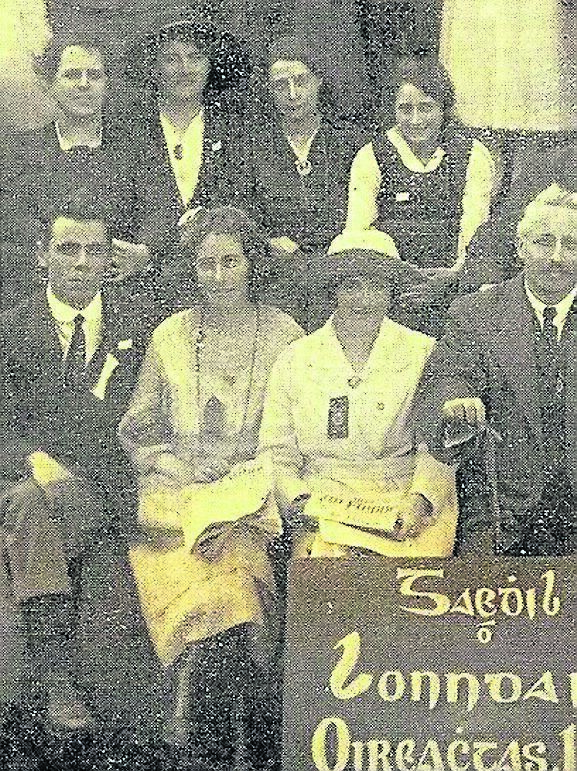Clodagh Finn: Meet Mairin Mitchell — honoured abroad but unknown at home

Xabier Armendariz, curator of the Mairin Mitchell exhibition, which was organised by the Biscay provincial council; Euskal Herria Museum head Leire Irazabal; and Basque language, culture, and sports deputy Lorea Bilbao Ibarra.
If you happen to be passing through Guernica in the Basque country in Spain in the next few months, you might be taken aback to find that an Irishwoman, Mairin Mitchell, is the subject of a major exhibition at the Euskal Herria Museum. The writer, linguist, traveller, and geopolitical analyst is celebrated as “the Irish chronicler of the Basques”, yet she is hardly known at home.
To be fair, she wasn’t very well known there either until maritime historian and sailor Xabier Armendariz dedicated himself, “body and soul” as he put it, to rescuing her from obscurity. The result is a fascinating portrait of a woman who spoke several languages — German, French, Spanish, Russian, and Greek — and probably worked with the Allies as a translator during the Second World War.
However, that is the least of her work. She was a writer, an inveterate traveller, an Irish Press correspondent, an anarchist (but a pacifist and a Catholic too), and a woman with a deep interest in the Basque country, hence the interest in her there.
As Armendariz notes: “Every time something was published about the oldest languages in Europe, for example, she would send a note or write an article stating that the oldest language was that of the Basques. She defended the language and also acted as an disseminator of Basque culture in the English-speaking world.”
Her writing about Spain was also well-reviewed and considered influential in its time. George Orwell wrote that you had to read Mitchell’s book, Storm Over Spain, to understand the Spanish Civil War. She wrote to thank him for his kind review but said that she was Irish rather than English, as he had written.
Mitchell was born in England in 1895 but never considered herself English. Her father, Thomas Houghton Mitchell, left Limerick to study medicine in England. He married Gertrude Emily Pease and spent the rest of his life there.
Mairin Mitchell, one of four children, considered herself Irish like her father and went on to become an active member of the Gaelic League of London.

The only known picture of her was unearthed by journalist and researcher Amaia López de Munain. It was taken in the 1920s during a visit by the Irish League of London to Dublin.
In the 1930s, Mitchell worked as a correspondent for the Irish Press, filing her ‘Traveller in Time’ column as she wandered about Europe, “from Lapland to the Aegean Sea”, as she described it.
The newspaper itself enthused about her books and essays, describing them as “a delightful medley of personal adventure, novel information about politics acquired at first hand, and the reflections on these things of an essentially Irish Mind”.
“On her last holiday she handed a copy of the new Irish Constitution to the head of the Principality of Liechtenstein,” the Irish Press noted in 1937. “She has given new light on Irish problems to friends in Hungary, the Basque Country, and innumerable out-of-the-way corners of Europe. She will not be satisfied until she has travelled among the Tartars.”
She explained that she got the travelling bug from an uncle who was a sailor. In Back to England (1941), she wrote: “The world would be a poorer place without people like my sailor uncle who could tell stories about most of the world, roar old sailor songs and do it with funny airs. It is not surprising that, therefore, if the mind of a child is placed early in the distant places carried home by a globetrotter, when I grew up I decided to be a writer, hoping to see something of the world.”
Armendariz was amazed to find that she had even gone to Ethiopia.
“She was absolutely independent her whole life [Mitchell died in 1986, aged 91],” he said.
“She was an exceptional woman and she moved around Europe in the interwar period. But there are amazing things, like when the Royal Society — she was elected a fellow of the Royal Geographical Society in 1946 — sent me her induction speech and I see that the speech is about the people of
Ethiopia. She had also gone to Ethiopia!”
Her detailed and meticulously researched book The Maritime History of Russia 848–1948, (1949) shows she also had a deep understanding of that part of the world.
She travelled in the other direction too, working as a stenographer on a boat to Canada and, according to her own account, while there she was initiated into the First Nations people, the Iroquois.
Closer to home, she knew Irish women’s rights campaigner Hanna Sheehy Skeffington and writer, historian, and Sinn Féin activist Desmond Ryan. She was also a regular contributor to the Irish media.
So why has she been forgotten at home?
“To date, Mitchell has barely bothered a footnote,” historian Maurice J Casey noted a few years ago, suggesting that she had slipped through the historical gaps possibly due to her gender, her location, and her esoteric choice of writing subjects.
Casey offers this evocative vignette of her joining comrades from a London anarchist circle in 1918 on the rooftop of a Euston Rd flat: “Amid the smell of rooftop lead melting in the August sun, the friends talked of Marx, Hegelian dialectics, what Ireland might look like in the 21st century, and communal experiments from Limerick to South America.”
Later, Mitchell recalled those post-war revolutionary hopes and their failures, and said sometimes conversation was all the youth could afford and it provided a great adventure.
“Better in youth the endless talk, even the ‘isms’ that show the divine discontent, than the young who do not question and who never rebel,” she wrote.
Casey goes on to say that the experiences of the hidden diaspora, who often spent lonely decades on the margins, is important because it helps to explain events such as #HomeToVote in 2018, when thousands returned from abroad to Ireland to vote on whether or not to repeal the eighth amendment to the Constitution.
Back in Guernica, Mitchell’s considerable presence and influence in the Basque Country is being explored in an exhibition that runs until next February.
“With this exhibition, the idea that people had of her is turned upside down. Her personality is absolutely fascinating,” Armendariz says.
Maybe that exhibition will give us a prompt to talk about her, and so many other forgotten emigrants, at home.
CONNECT WITH US TODAY
Be the first to know the latest news and updates











